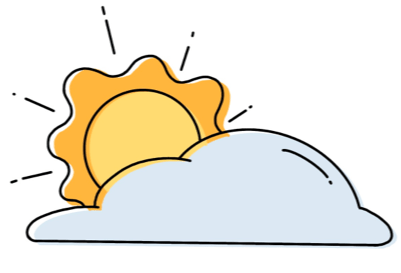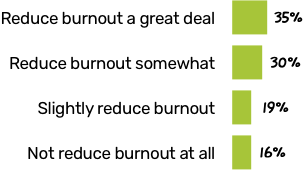Report
Hybrid work models should consider employee burnout


Hybrid work promises employees coveted flexibility… and plenty of potential anxiety.
New research from Eagle Hill shows that more than half (53 percent) of US employees continue to feel burnt out. Hardly surprising. Organizations and employees have endured life-altering change over the past year and a half. Amid this change, employee burnout—while not a new topic—has certainly elevated to new heights.
Yet Eagle Hill research shows some signs the waters may at last be starting to settle. We have monitored employee burnout with pulse surveys since April 2021. And while workload has remained a consistently cited source of burnout for our respondents, other underlying causes have begun to alleviate. The percent of respondents who cited juggling personal and professional lives as a source of burnout dropped from 44 percent to 35 percent between May and August 2021. Likewise, time pressures as a source of burnout edged slightly down during that same timeframe, from 37 percent to 32 percent (Figure 1). We consider these nascent signs that employees have started to find their footing again, despite the difficulty of the long adjustment.
Despite the difficulty of pandemic adjustments, Eagle Hill sees emerging signs that employees have started to regain their emotional footing.
Now, as the pandemic continues to evolve, many companies plan for a hybrid work model, giving employees continued flexibility to work from home. Unfortunately, how they institute these models may have unintended consequences. Employers have spoken of the return to work since the start of the pandemic, but according to Gartner®, as of late August 2021, 66 percent of organizations are delaying office reopenings due to COVID-19 variants. Moreover, most organizations have only begun to articulate the details of this new way of work in practice.
As organizations postpone reopening and continue to provide vague details of what hybrid work will look like, employees are full of questions about what this new change will mean for them. In fact, psychologists have even termed this phenomenon “reentry anxiety”—stress related to going back to normal after more than 18 months where social distancing meant safety.
Eagle Hill’s research and analysis of trends leads us to ask: How will hybrid work? Will the promise of greater flexibility substantially alleviate burnout, or (like most change) will it induce anxiety and stress and exacerbate burnout? What should companies that can’t offer hybrid models do? And crucially, how do organizations avoid upsetting the equilibrium that employees have created for themselves since the start of the pandemic? Eagle Hill research uncovers two noteworthy findings for organizations.
Question: What are the causes of you feeling burnout at work?

Figure 1. Employees have begun to gain ground against the time pressures and work-life balance issues that COVID-19 exacerbated.
Source: Eagle Hill Consulting
Finding 1: Going hybrid means another upheaval for weary employees.
While remote work can have many benefits, the backdrop of remote/hybrid work today amid the pandemic is anything but normal. Employees have been thrown into brand-new routines, and many have had to change how they structure their days with school cancellations, increased care-taking responsibilities, and revised commutes.
In addition to the changes to employees’ personal lives, their work lives have also changed. In a recent Eagle Hill poll of US employees on virtual performance management, 36 percent of respondents said the very nature of their day-to-day work has changed during the pandemic.
The shift to hybrid work models means employees will once again have to reshape their personal and professional lives. They may need to adjust the routines they’ve worked so hard to build amid the pandemic yet again, potentially increasing stress and fatigue.
For many employees, hybrid work will also mean coming up with different routines as they juggle working from home some days and hustling between work and their personal responsibilities when they’re expected at the physical workplace. New routines and new types of work will put employees in round-the-clock “go, go, go” mode and organizations must support employees amid this burnout-inducing scenario.
Finding 2: Collaborating and connecting with colleagues is about to get complicated.

Burnout does not come solely from overwork. Isolation and having few channels through which to share ideas, receive support, and gain affirmation all take significant tolls as well. Research shows that those who work from home talk less to coworkers, and we know communication and collaboration are key to success. When asked what they prioritize at work, 70 percent of employees said their relationships with coworkers are equally as important as the work itself (Airtasker). In addition, studies have long shown that frequent in-person interactions lead to commitment, support, and cooperation among people on teams. Ultimately, employees’ peer-to-peer connections hit the bottom line.
As employees build hybrid work arrangements, connecting with teammates, peers, and colleagues may become an exercise in coordination. Organizations need to prioritize defining how employees will collaborate and maintain a sense of belonging if individual schedules don’t align. Meetings and collaboration tools certainly offer opportunities to work from different locations, but there’s a lot that is said, done, and shared in between formal calendar invites.
If pockets of the workforce feel left out, it can result in greater isolation, ultimately resulting in unnecessary stress and burnout.
Given employee burnout is a multi-faceted and complex challenge, organizations need multi-dimensional solutions to mitigate and prevent burnout. While a hybrid work model may seem to meet the needs or wants of most employees, it’s still a change. And any change—if left unmanaged—leads to more anxiety, stress, and ultimately, greater burnout.
Eagle Hill recommends:

Manage return to work, whatever shape it takes, as the enormous change that it is.
To support employees through the changes ahead, key leaders across the business, such as HR, Operations, and Technology should collaborate to define a cohesive strategy and solid change management plan that results in a seamless transition for employees.
Think through all the dimensions of process change as employees toggle between remote and in-person work as well as the training and technology needed to build strong teams that can work from anywhere.
Then, clearly articulate through multiple channels what hybrid work will look like for employees and who they should talk to if they have any concerns.
This last point deserves special emphasis. In our survey, 44 percent of employees said that lack of communication, feedback, and support contributes to their burnout.

Build flexibility into your hybrid work models.
The pandemic has taught us that everyone’s personal circumstances are different. Some thrive working remotely, others crave the connections of the office environment, and still others simply don’t have the choice to come back.
Regardless of your organization’s hybrid work plan, building in as much flexibility as possible to accommodate the different needs of your employee population will help reduce burnout. In our survey, 84 percent of employees said that increased flexibility of working hours/days would reduce burnout (Figure 2).
The numbers were notably high among certain segments, likely reflecting where care-giving burdens fall most heavily. 87 percent of employees between the ages of 18-34 said increased flexibility would reduce their burnout (versus 72 percent of employees over 55), while 82 percent of women overall agreed (versus 85 percent of men).
Question: How much would increased flexibility at work reduce your burnout?

Figure 2. Building flexibility into hybrid models will lower employee burnout.
Source: Eagle Hill Consulting
Regardless of your organization’s hybrid work plan, building in as much flexibility as possible to accommodate the different needs of your employee population will help reduce burnout.

Optimize workforce capacity and balance workloads.
According to our research, more than 1/3 of employees say their day-to-day work has changed during the pandemic. To better balance workloads and equip employees to handle shifting responsibilities, organizations should take a data-driven approach to make sure they have the right people in the right roles at the right time. Quantifying workload requirements compared to current workforce capacity will help identify workforce capacity gaps and surpluses, where to redistribute and realign workload, and where to prioritize adding resources. It will also give insight into any “span of control” issues or performance variations across the organization.

Equip team leads to create cohesive “work anywhere” teams.
Team leads play a critical role in creating a positive employee experience and building team resilience in a hybrid work environment. Organizations should provide team leads with the right tools and coaching to create “work anywhere” teams—teams that come together regardless of where individuals work. They also should hold team leads accountable for monitoring information gaps when teams work in a hybrid environment; keeping remote employees updated when information is shared outside of formal meetings; and regularly checking in with employees to gain their perspectives on how well the team works together in the new environment. These steps can empower team leads to identify potential signs of burnout and take proactive steps toward addressing issues.
To go a step further, organizations that define shared team goals and metrics help create a sense of camaraderie among employees. In our survey, 25 percent of respondents cited not feeling connected to colleagues as a source of burnout. Having “someone else’s back” creates a sense of purpose at the individual level. Shared metrics keep employees connected to their peers and create opportunities to celebrate interim successes together along the way.

Promote a culture of health and well-being.
Finally, to truly move the needle on employee burnout amid hybrid work, organizations need to prioritize and place greater value on employee health and well-being both in the office and at home. In our survey, 78 percent of employees said better health and wellness benefits would have a positive impact on burnout.
While investments in wellness programs and benefits is a step in the right direction, organizations should go further and consider how their underlying cultures may support or undermine employee wellness. For instance, they should consider whether employees are regularly sending emails late at night, if they eat lunch at their desks, if they mingle, and so on. Define the organizational culture from the perspective of how it promotes employee well-being and expect leadership to set expectations and model good behaviors around digital wellness for employees.
Ultimately, doing hybrid work right amounts to a change challenge. Launching a hybrid work strategy, or any new work strategy, requires understanding your employees’ unique needs. Organizations without strong change management supported by in-sync leaders across the board set themselves up for a disappointing return—because for employees, the change back to “normal” just won’t feel normal at all.
Gartner Press Release, “Gartner HR Poll Finds Two-Thirds of Organizations Are Delaying Workplace Reopening Due to New COVID-19 Variants”, 31 August 2021. GARTNER is a registered trademark and service mark of Gartner, Inc. and/or its affiliates in the U.S. and internationally and is used herein with permission. All rights reserved.

